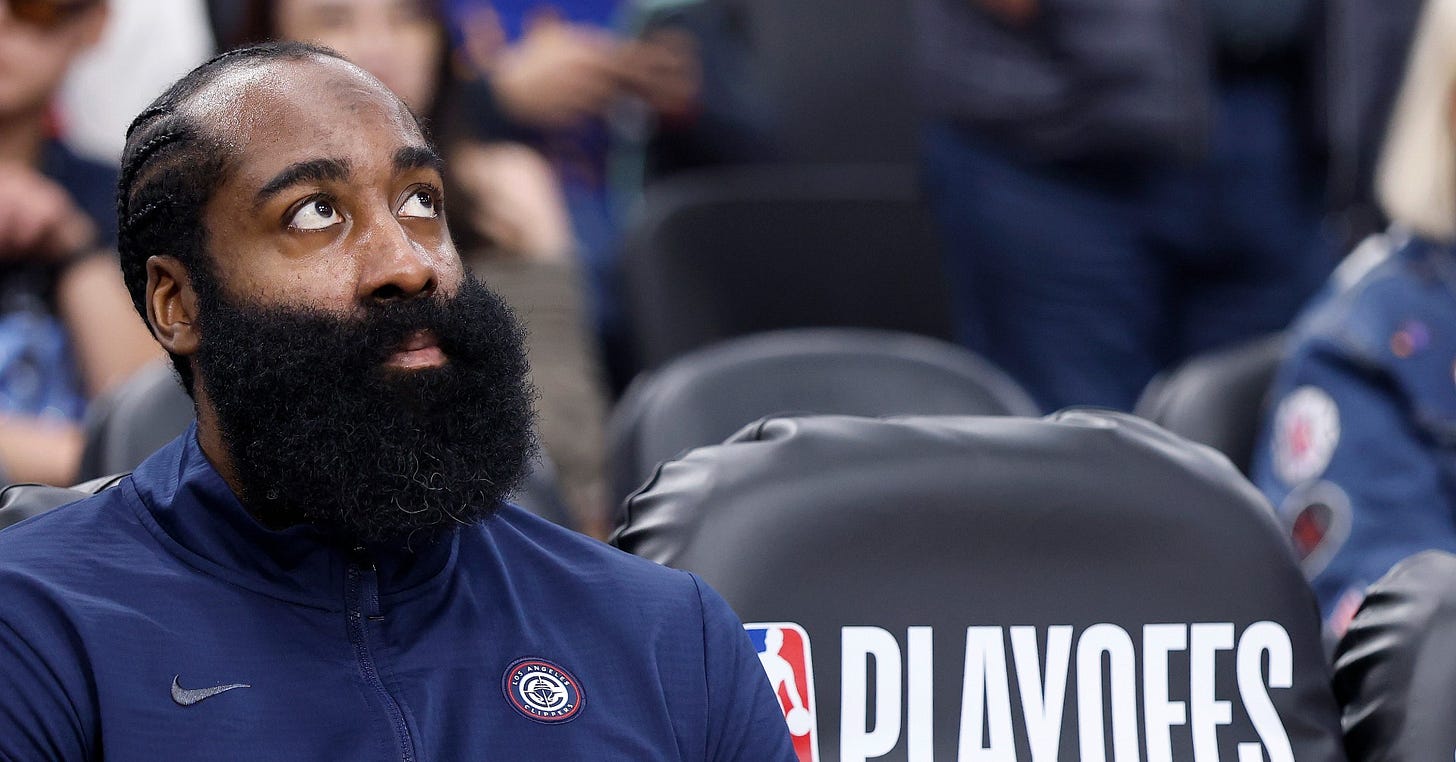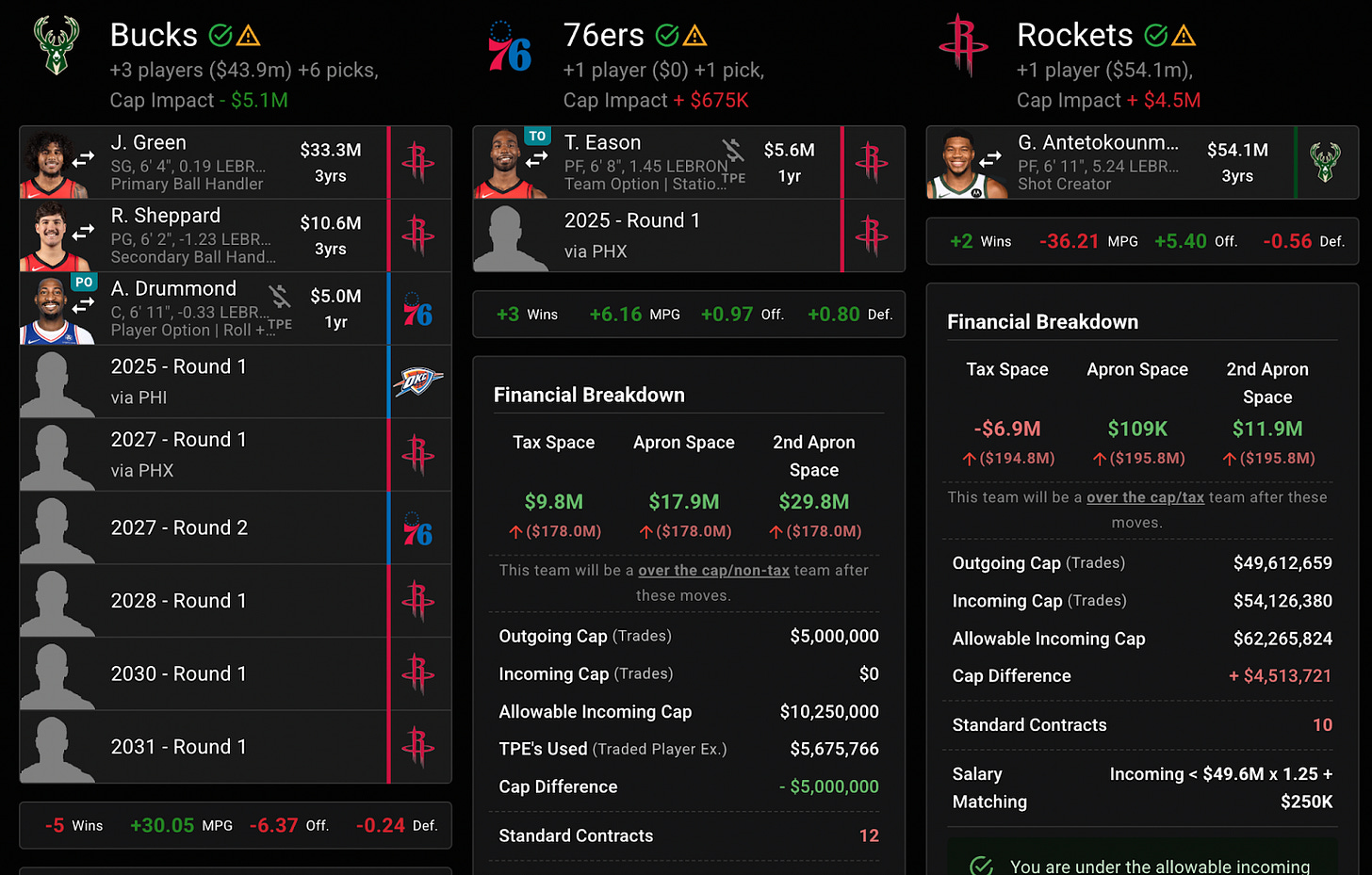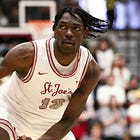4 Sixers-Related Thoughts From the Playoffs So Far
MOC with a handful of takeaways about how to win from a postseason without the Sixers.
Despite the Sixers’ absence from the playoffs this year, I’ve still found myself thinking about a lot of Sixers-related topics while watching these games over the past few weeks. There are notable former Sixers playing central roles in the storylines of these playoffs, and there are lots of Sixers-related lessons to be learned from the teams that have succeeded so far. Let’s get into a few things that have jumped out at me.
Can we close the book on the James Harden conversations?
Over the course of the past year, as the Sixers’ season spiraled out of control and James Harden put up a truly impressive regular season for a 50-win Clippers team, it became an increasingly popular sentiment among some factions of Sixers fans to bemoan the loss of Harden in the 2023 off-season as a death blow to this era. Many wished that the Sixers had re-signed him, and that the Sixers continued to give the Embiid-Harden duo more chances to break through together in the playoffs.
Suffice it to say, those voices seem a bit quieter now that Harden has once again reminded us of exactly who he is in these playoffs – an incredible regular season floor-raiser who folds like a lawn chair in the late stages of every playoff series. His terrible 2-8 shooting performance in the Clippers Game 7 loss was the latest in his history of many, many horrific elimination game performances.
Harden’s remarkably consistent habit of completely disappearing late in a series – often after having strong games early on, like we witnessed in 2022 and 2023 – ultimately made me completely fine with moving on from Harden, and I really never wavered from that stance even as his stock and the Sixers’ stock went in opposite directions over the past two seasons. Having to continue to root for a guy who consistently crumbles in the face of adversity would have driven me insane – to go through another 82 games of the team looking like a bonafide contender, with the only real question around the team being whether they have the mental wherewithal to win big in the playoffs, would have been miserable. I lived the James Harden experience for two years, and while I could say many positive things about his time here, I was thrilled to move on from him.
But let’s even set aside the playoff choking for a moment – I don’t think Sixers fans have quite grasped what a lucky break it was for them to be able to trade Harden at the time that they did. I suppose the best case to be made for keeping Harden is that he could have taken some workload off of Embiid and decreased the likelihood of injury, but that’s a bit of an abstract concept to pin your hopes on. In a world where Embiid still has health issues, the alternate reality where they keep Harden – presumably on a max or near-max deal – is incredibly bleak.
With Harden on the team, they likely are too good to be able to draft Jared McCain last season, and would likely have trudged their way to the play-in this year. All the while, they would be completely cap-strapped, and any win-now trades they made would have had to be done using precious future draft capital. The net impact of keeping Harden means no McCain, no top-5 pick (or any pick) this year, no future Clippers picks, likely one or two more future firsts out the door, and still no championship to show for it. Every national pundit right now would be comparing them to Phoenix or Milwaukee.
Would the last two regular seasons have been an easier watch with Harden around? Of course! Could they have won a playoff round in 2024 with him? Maybe. But there would still almost certainly be no new banners hanging in the Sixers’ facility, and their next 5-10 years would look massively worse.
The Sixers should hop into a Giannis trade as the third team
I’ve mentioned the possibility a few times of trading back in the draft, particularly if the Sixers’ pick lands in the 3-6 range, and I think that the perfect opportunity for them to do so would be if the Houston Rockets wind up being the team that trades for Giannis Antetokounmpo.
Houston currently owns Phoenix’s pick, which is slotted ninth in this year’s draft. If the Sixers end up at number three or four, I’d be desperately trying to pry away one of Tari Eason or Jabari Smith from that trade, and swap the third pick for number nine. With Milwaukee having somewhat of a blank slate moving forward, I imagine that a top-3 pick would be much more appealing to them than the ninth pick.
It’s possible that this trade just doesn’t get done without one of Amen Thompson or Alparen Sengun in the deal, but five first round picks, with one of them being the third pick in this year’s draft, is not something to scoff at.
Regardless of what the framework ends up being, if the Sixers can successfully snag one of Houston’s long, athletic wings while also getting the ninth pick, that’d be an incredible outcome from draft night. Snag one of Derik Queen or Collin Murray-Boyles with that pick, and I’d be happy with the shape of the team heading into next year regardless of what else happens in the off-season. Given that the Sixers would likely be forced to choose between some ill-fitting pieces if they stayed in the 3-4 range in the draft, trading back to grab both a young player and a draftee that both fit just makes too much sense.
A starting five of Maxey-Grimes-George-Eason-Embiid, with a bench of McCain-Edwards-Oubre-Yabusele-Queen, is an incredibly fun unit on paper. That team would be electric to watch – for the 10-15 games that they’re all healthy, anyway.
The league is trending away from the “stars and scrubs” model
I’m not the first person to make this observation, but it’s increasingly clear with each passing year that depth is becoming more and more important and that the old model of building a “Big 3” with a bunch of barely competent role players around them is no longer the most optimal way to build a contender. The Thunder, Wolves, Cavs, Rockets, and Pacers are all good examples of this. Hell, even the Nuggets prove this point to an extent – despite lacking bench depth, they’re a good example that having multiple players just below All-Star level who complement your best player, like Aaron Gordon and Jamal Murray, is better than, say, the Bucks’ route of simply going all-in around two supermax players.
What does this mean for the Sixers? Well, they’re already a bit too committed to the Big 3 model (insofar as you could still call Embiid-Maxey-George a “Big 3”) to pivot now. But the fact that depth is becoming more and more valuable in today’s league helps make the case for my suggestion of trading back in the draft. It also highlights the importance of re-signing players like Grimes and Yabusele, as a team like the Sixers simply can’t afford to let quality rotation players walk out the door.
If the Sixers are going to win anything with their current core, it’s going to come in large part thanks to smart moves around the margins that help build out their depth with cheap, quality talent. Hitting on players like Jared McCain, Justin Edwards and Adem Bona last off-season was a big step in the right direction. This year, they’ll have to try to come out of the draft with multiple real contributors, and pay the price in free agency to keep proven rotation players like Grimes and Yabusele.
Coaching matters less than we think
Another dynamic that has really been emphasized throughout these playoffs is the degree to which coaching simply does not matter. If the Denver Nuggets can fire their coach of nearly a decade, turn to an assistant with no head coaching experience, and suffer no noticeable ill effects whatsoever, coaching probably just isn’t as important as we all make it out to be – especially considering that they beat a Clippers team with one of the most universally respected head coaches in the league in Ty Lue.
This obviously does not mean that the act of coaching is meaningless; of course you need a good staff of capable basketball minds to keep your team prepared and perform all of the duties coaches have. But what it does show is that the relative advantage of one coach compared to the next is very, very small – there are probably 40 or so assistant coaches floating around the league who could do a replacement-level job for most teams, especially in the playoffs, when rotations shorten and every team is narrowing down the number of plays and schemes that they run.
A large part of coaching, in my opinion, is simply about fit. Nick Nurse’s coaching style was a good fit for the 2023-24 Sixers, but a bad fit for the Embiid-less 2024-25 Sixers. Same thing for Brett Brown in 2017-18 versus 2018-19. Coaches tend to be stubborn and want to play a certain style; if it doesn’t fit the roster they have, many coaches simply will not adjust.
Regardless, it is likely worth all of us taking our expectations down a notch on just how important coaching is. The relative advantage of one NBA coach versus the next is smaller than it’s ever been.
Mike O’Connor is the best O’Connor in basketball writing. Previously of The Athletic, you can find Mike on Twitter @MOConnor_NBA. Mike’s writing is brought to you by Body Bio, supplements based on science, focusing on your gut and brain health.







Like the article even if I disagree with some of the takes. Mainly the draft ones. Coming out of the draft with a big who can’t defend or shoot and has passing flashes more so than is an actually good passer OR a 6’7 obligate power forward who can’t shoot and is also just a pretty good rebounder is…gross tbh.